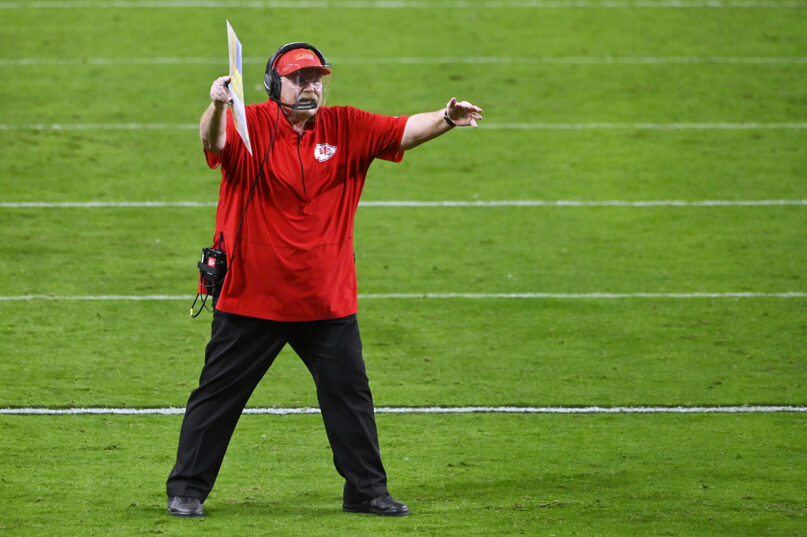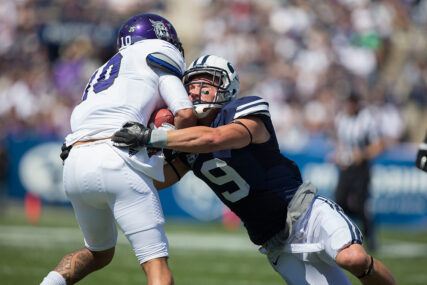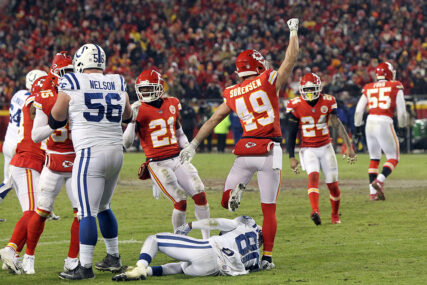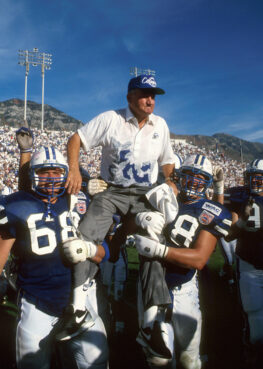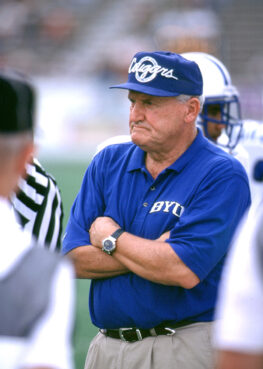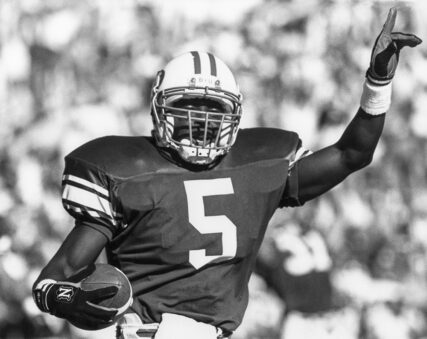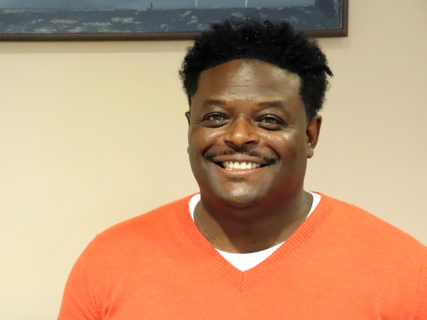(RNS) — Kansas City Chiefs head coach Andy Reid was in a bind.
His team faced a fourth down and a yard to go with just over a minute on the clock, while clinging to a 5-point lead over the Cleveland Browns.
The team’s star quarterback, Patrick Mahomes, had been knocked out of the game with a concussion.
If the Chiefs made a first down, the game would be over. If the Chiefs punted or failed to get a first down, the Browns, who had mounted a furious comeback, would have a chance to upset the defending Super Bowl champs.
Reid went for it. But instead of trying to run for a first down, he asked backup quarterback Chad Henne to roll out and toss a pass to a wide-open Tyreek Hill, sealing the victory.
The risky play surprised the Browns and almost everyone watching. But for Reid, it was the right call — and one he’d been preparing since his days at Brigham Young University, the flagship school of the Church of Jesus Christ of Latter-day Saints.
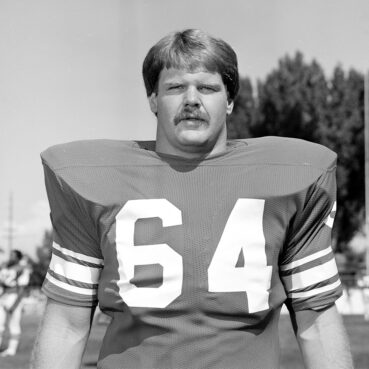
Andy Reid as a player in 1981 at BYU. Photo courtesy of BYU
“I went to BYU,” he said after the game. “Every down’s a throwing down.”
Reid’s decision was an act of faith in his team. It was also a testimony to the long and fruitful relationship between Brigham Young University — and the Mormon faith — and the game of football.
It’s a relationship that helped redefine both the sport and the religion.
“Latter-day Saints and football found each other at a time when both desperately wanted to become part of the American mainstream,” said Joseph Stuart, a doctoral student at the University of Utah who has studied the long connection between Latter-day Saints and sports.
At the turn of the 20th century, said Stuart, the Mormon church was trying to change its image. It had clashed with the broader American culture, sometimes violently, because of its religious claims, especially the practice of polygamy.
After the church dropped polygamy and Utah, the church’s home base, became a state, the church began to rebrand itself.
“Mormons were trying to Americanize,” Stuart said. “They were trying to assimilate into American culture. And sports is one of the easiest ways to do that.”
The church’s emphasis on sports also fit into the broader social gospel idea of the time — which viewed physical fitness as a spiritual practice.
Latter-day Saints resonated with that idea. Joseph Smith, the church’s founder, had taught that the “body and spirit are the soul of man,” linking the physical and the spiritual. Church-run sports programs became a way to connect the two while also identifying with the broader American love of sports.
RELATED: Does God give a holy hoot about the Super Bowl?
As football became America’s sport, Latter-day Saints embraced the game and excelled both in college and professional leagues. There are dozens of church members currently in the NFL, including Kansas City Chiefs safety Daniel Sorensen, and hundreds more who have played in the NFL in the past, including Hall of Famer Steve Young.
- Bringham Young’s Daniel Sorensen, right, makes a tackle against Weber State on Sept. 8, 2012. Photo by Jaren Wilkey/© BYU PHOTO
- Chiefs defender Daniel Sorensen, center, celebrates after making a play against the Indianapolis Colts, Jan. 12, 2019. RNS photo by Kit Doyle
Coach Andy Reid of the Chiefs is a member of the church, as is Alex Guerrero, Tampa Bay quarterback Tom Brady’s controversial trainer and spiritual adviser.
Stuart said football and other sports took the spotlight off Mormon theology and practice and allowed church members to focus on the things they had in common with other Americans.
Latter-day Saints aren’t the only religious group to embrace football. From its earliest days, football was seen as a way to develop moral character and leadership skills, especially by early proponents like Amos Alonzo Stagg, the legendary football coach at the University of Chicago.
Stagg was a key figure in the “muscular Christianity movement,” which saw physical fitness as a sign of spiritual growth, said Paul Putz, assistant director of the sports ministry program at Baylor’s Truett Seminary.
While working for the Young Men’s Christian Association, now known as the YMCA, Stagg had been a colleague of James Naismith, the inventor of basketball, and helped popularize the game.
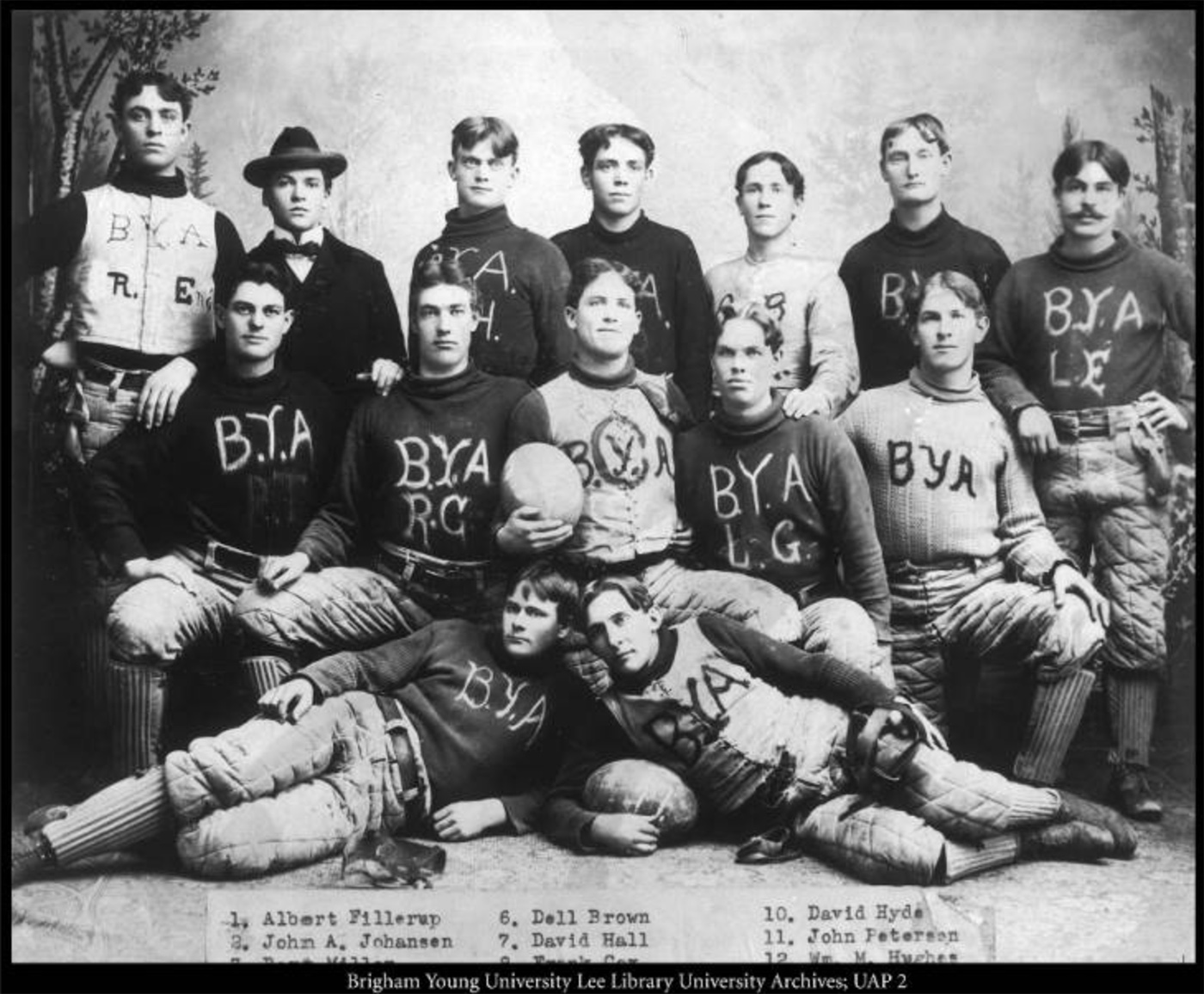
The Brigham Young Academy football team in 1897, their second year of competition. Courtesy University Archives, L. Tom Perry Special Collections, Harold B. Lee Library, Brigham Young University
He did the same for football at a time when the game was controversial. Eighteen players died in 1905 while playing football, which was more like rugby than the modern version of the game. Brigham Young University, which had started a team in 1896, shut down its team for most of two decades because of the game’s violence.
RELATED: Patriots ‘character coach’ Jack Easterby joins long tradition of chaplains
Stagg helped redeem the game. He argued the game was worth playing because it was designed to build the character of players. And even as the game’s rules changed to make it safer, the idea that football could develop moral leaders remained. Because of that, football coaches gained a certain moral authority coaches in other sports didn’t have.
That has led to a long tradition, said Putz, of football coaches and players mixing sports and religion. In the NFL, Super Bowl-winning coaches Tom Landry of the Dallas Cowboys and Joe Gibbs of the Washington Football Team were known for their devout and outspoken Christian faith.
During the 2017 NFL season, the Philadelphia Eagles’ road to the Super Bowl was fueled in part by faith. A number of high-profile players, like quarterbacks Carson Wentz and Nick Foles, were outspoken Christians. The team’s coach once worked for a Baptist high school, and the team’s offensive coordinator was a former seminary president.
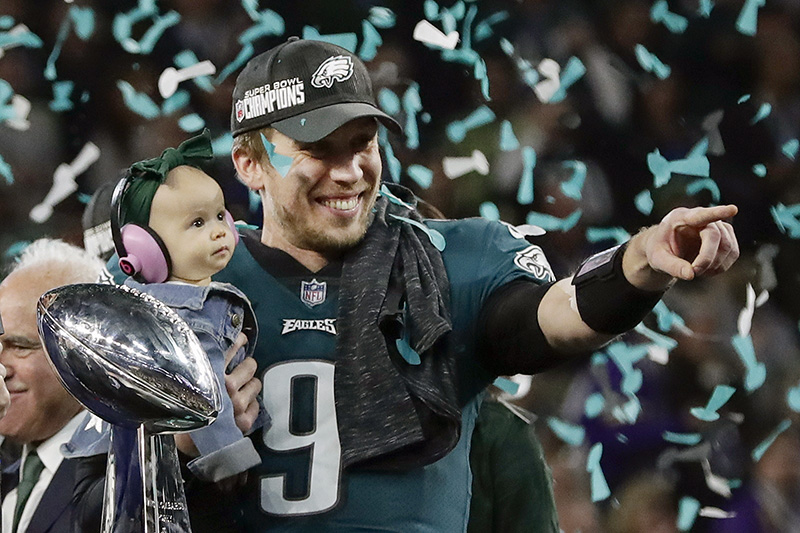
Philadelphia Eagles quarterback Nick Foles holds his daughter, Lily, after beating the New England Patriots in the NFL Super Bowl 52 football game Sunday, Feb. 4, 2018, in Minneapolis. (AP Photo/Frank Franklin II)
Their success led to a book called “Birds of Pray,” which cited faith as key to the team’s success. But just a few years later, the team cratered. The coach was fired, and other key players moved on. Now, no one is talking about the team’s religion.
“I am guessing they are no less Christian now than they were when they won the Super Bowl,” said Truett’s Putz.
Mormon athletes, said Putz, take a less evangelical approach to religion and football. They are more likely to speak about faith and family than to use their success to invite others to put their faith in Jesus.
Latter-day Saints have also had a profound effect on the way the game is played, said Hunter Hampton, assistant professor of history at Stephen F. Austin State University in Texas. That influence is especially true of legendary BYU coach LaVell Edwards, said Hampton, who has studied the history of Brigham Young Football.
“There is an argument that he is the father of modern football,” said Hampton, “because of his embrace of the passing game.”
- Brigham Young University players carry coach LaVell Edwards on their shoulders in Sept. 1994. Photo by Mark Philbrick/© BYU Photo
- Coach LaVell Edwards on the BYU sidelines. Photo by Mark Philbrick/© BYU Photo
Knowing he could not compete with larger schools for the best athletes, Edwards instead focused on developing a creative approach to offense. Rather than building a strong running game, his teams threw the ball all over the field.
His approach would eventually lead to the creation of the so-called West Coast offense, which propelled the San Francisco 49ers to four Super Bowl wins, and the “Air Raid” offense, which is popular in college football.
When he watched the Chiefs play, Derwin Gray, who starred for BYU and played for the Indianapolis Colts in the mid-90s, sees many of Coach Edwards’ plays still at work.
Along with being a great coach, Edwards was a beloved mentor to his players, said Gray, who is now pastor of Transformation Church, a multicultural megachurch near Charlotte. When Gray went to BYU, he was not religious at all. But the school’s honor code, he said, gave him a moral framework for his life.
And Edwards became a mentor and friend.
“He believed in me,” said Gray.
- Derwin Gray playing for BYU in 1991. Photo by Mark Phillbrick/© BYU Photo
- Derwin Gray in 2020. RNS photo by Adelle M. Banks
Edwards, said Stuart, typified the idea that a coach is also a spiritual leader. In 1984, the same year BYU won college football’s national championship, Edwards addressed a men-only session of the General Conference of the Church of Jesus Christ of Latter-day Saints.
In that speech, he spoke about the spiritual lessons he and his players learned from the game — especially about the importance of preparation and perseverance.
He also spoke about encouraging young people to go out on the traditional Mormon two-year mission, which would change their lives. And he spoke of the power of faith in overcoming adversity.
“I can assure you, brethren, everyone has problems — even football coaches. The ability we have to handle this adversity will determine the degree of success that we will have in life. To me, this is where the gospel can be the greatest of help to us.”
Hampton, of Stephen F. Austin State University, said he sees hints of Reid’s faith in his coaching style. Reid, despite his gruff exterior, is almost universally beloved by his players and opponents alike. He has also been willing to give troubled players a second chance, including Tyreek Hill, who was involved in a domestic violence incident and Terrell Owens, the talented but controversial receiver who played for Reid in Philadelphia. Reid, who lost his son to a drug overdose, seems to believe in redemption.
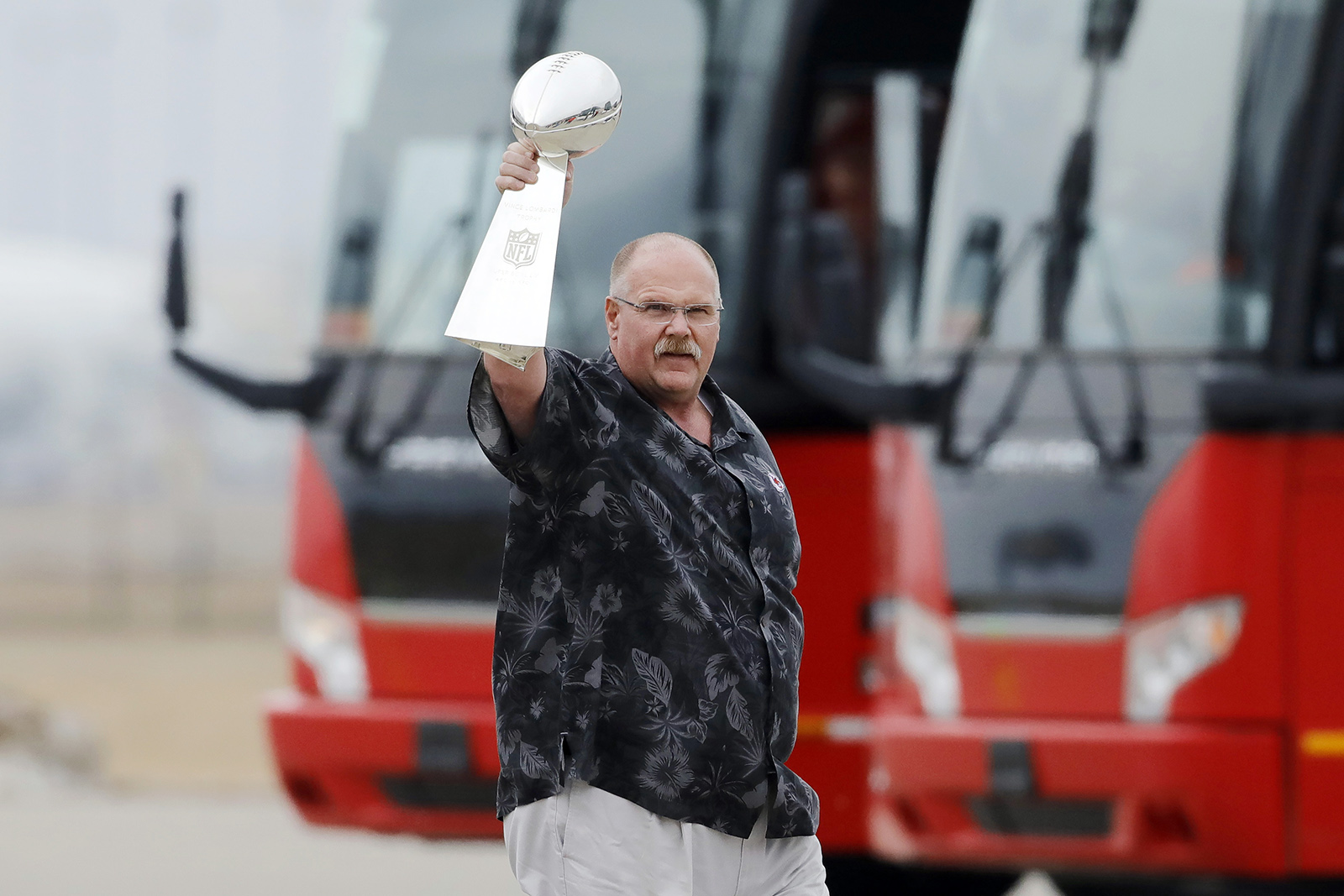
Kansas City Chiefs head coach Andy Reid holds up the Vince Lombardi Trophy as his team returns home a day after winning the NFL Super Bowl 54 football game, Monday, Feb. 3, 2020, in Kansas City, Mo. The Chiefs defeated the San Francisco 49ers 31-20, to win their first championship in 50 years. (AP Photo/Colin E. Braley)
Jessica Nelson, who works in the church history department at the Latter-day Saints headquarters in Salt Lake City, comes from a family where sports and religion are a normal part of life.
Her mom played basketball for BYU, as did one of her aunts. Her brother plays football for BYU, and a cousin, Porter Gustin, plays for the Cleveland Browns.
She said the church has embraced sports as a way to connect with broader American culture — but also to bring congregational members together. Sports, she said, also helped keep church members away from worldly influences.
“Athletics is one of the ways, when it is done right, that shows how the church can shine,” she said. “It is good to see the Mormon brand represented well.”
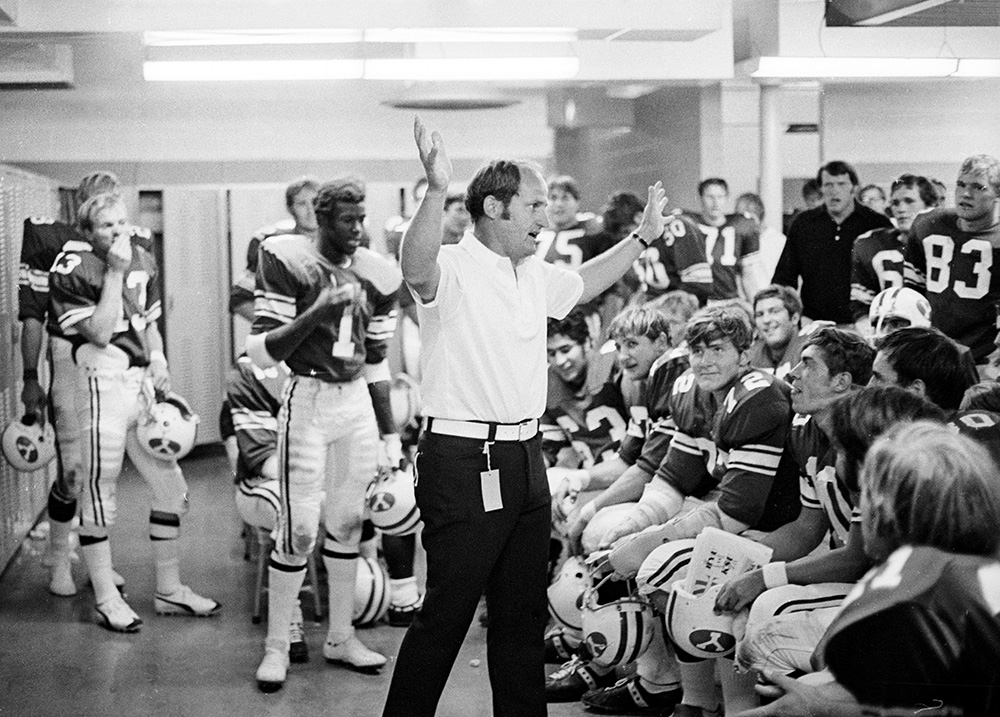
Coach LaVell Edwards, center, in the locker room with his BYU team during his first game as head coach on September 16, 1972, against Kansas State. © BYU Photo
